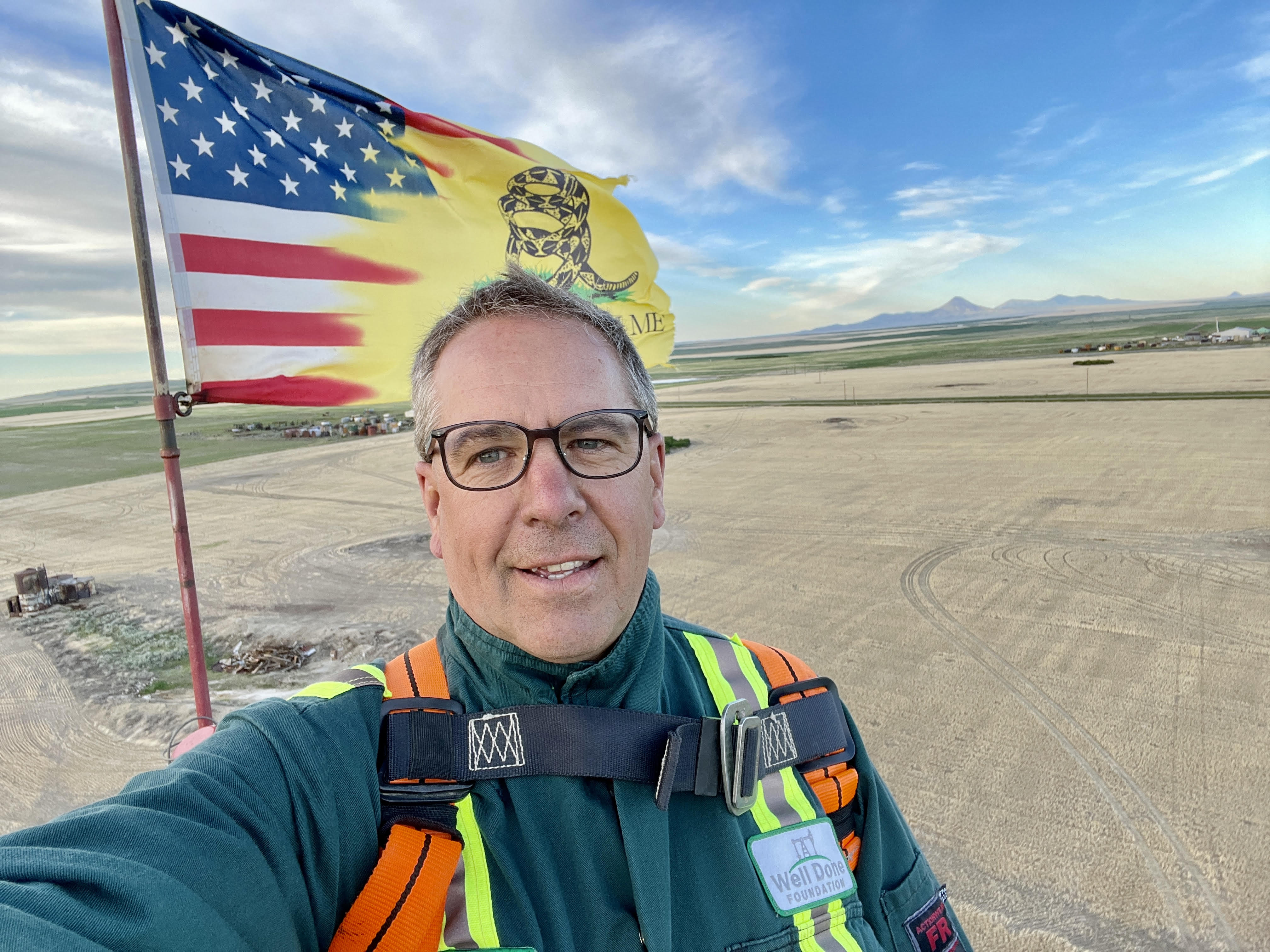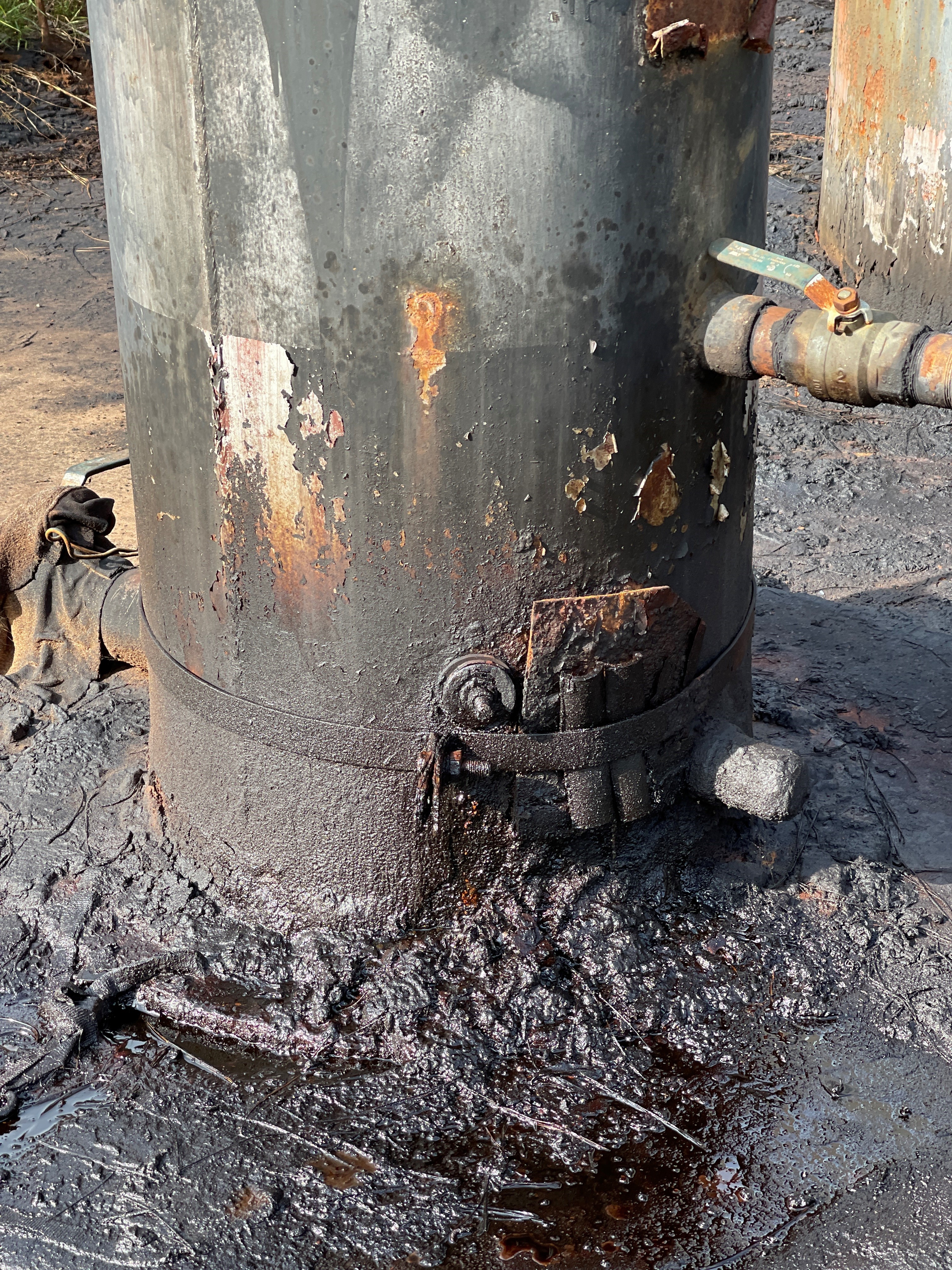Presented by:
When Curtis Shuck saw his first orphaned well in northern Montana about two years ago, the sight of the dilapidated fixture shocked him.
“I was absolutely horrified by the condition at the surface and could not believe that from an oil and gas industry perspective that it was in any way acceptable or that it could have any positive reflection on the industry,” Shuck
said. “I felt strongly that—now that I had seen the condition—that I could not unsee it and that it was incumbent upon me to take some action.”
On his drive home to Bozeman that night, the idea for the Well Done Foundation was born.
The company, which Shuck today leads as chief executive, has been a frontrunner in the plugging of orphaned wells, a practice that’s becoming increasingly popular as the industry works to lessen its environmental impact.
It’s an issue that’s even on the radar of President Joe Biden, who earlier this year pledged to spend $16 billion capping noncompliant wells that have been inactive for at least a year.
By the EPA’s estimates, there are more than 3.2 million deserted onshore wells nationwide, including 2.1 million that are unplugged. It matters because the holes spew several million metric tons of CO2 per year, the agency said.
Although fossil fuel operators are legally required to properly shut out production wells,
they often lack the funds to do so and abandon the unprofitable fixtures.
The initial shock Shuck felt toward abandoned oil wells in 2019 has since been transformed into a determination to plug the holes and restore surface areas. In doing so, he’s permanently eliminating their carbon and methane emissions.
“Many of the orphan wells that we deal with have been leaking methane for years or even
decades,” Shuck said. “Left undone, these orphan wells will only continue to vent and release methane gas, some of them at really alarming rates.”
Trending topic
New research is highlighting the environmental and economic benefits of shuttering out-of-service oil and gas wells.
Plugging abandoned wells reduces air pollution while eliminating greenhouse-gas (GHG) emissions at a price in line with other options, a Columbia University’s 2020 Center on Global Energy Policy and Resources for the Future report found.
Conversely, the costs of ignored orphaned wells include heightened air pollution and environmental risks, the study said.
From the Well Done Foundation’s perspective, the greatest benefit comes from the immediate elimination of methane gas, one well at a time.
“(Our) mission is really methane-focused, and so identifying and plugging orphan oil and gas wells with high concentrations and flows of methane gas is our thing,” Shuck said.
“Methane as a greenhouse gas is 80 times more harmful than CO2, so besides just being the right thing to do, our work delivers an immediate benefit to the environment. It’s as simple as ‘gas on, gas off.’”

meaningfully,” said Curtis Shuck, chief executive, Well Done Foundation.
Methane has significantly more warming power than CO2 during the first two decades after reaching the atmosphere, according to the Environmental Defense Fund.
Of course, it’s not the only company taking the initiative, particularly as the industry works to align with ESG standards.
“There is certainly a lot of attention on the orphan well issue and how to get funding and deploy it meaningfully,” Shuck said. “Currently, with the price of oil being up, there is a lot of emphasis on production and new wells,
which makes resources such as workforce and equipment harder to find.
“However, that pendulum will shift again, and there will be capacity that can be used for more plugging.”
An unorthodox adoption Shuck’s vision stretches beyond the plains of Montana and toward the rest of North America. Although the Well Done Foundation began its work in Montana’s soil-rich Golden Triangle region—home to some of the nation’s most productive acres—its ultimate goal is to see each of the 3.2 million wells in Canada and the U.S. permanently shut.
The company expanded its pollution-fighting efforts in April with the formation of two strategic partnerships throughout Louisiana, East Texas, Pennsylvania, New York, Ohio and West Virginia.
By joining forces with the Pennsylvania-based Appalachian Legacy Project LLC and Louisiana-based OFC Solutions LLC, the non-profit was able to significantly scale up its operations.
Its growth streak continued in July through an expansion of an existing initiative with Alpine CapH4 LLC that aims to identify and remediate about 30 wells found to be the sources of significant methane emissions.
It aimed to have the wells closed within the next year and a half.
As the Well Done Foundation bolsters its efforts, it hopes other states follow suit.
“The orphan well issue boils down to simply doing the right thing, one well at a time,” Shuck said. “It has nothing to do with politics or what your view is on climate change or global warming. Leaving things better than the way you find them should always be a priority, regardless of how the situation came to be in the beginning.
“The Well Done Foundation is all about taking meaningful action that hopefully inspires others to support our efforts or do something meaningful themselves.”
Strategic approach
The Well Done Foundation’s well-plugging strategies are far from indiscriminate. Rather, the company takes a purposeful approach to its work by identifying high-emitting wells through a meticulous measurement and monitoring system.
Once it identifies wells most in need of plugging, it launches a fundraising campaign to finance plugging and restoration efforts.
“The Well Done program is designed to focus on the ‘super emitters’ first and foremost, and these can be found in almost every state that is facing orphan oil and gas well problems,” Shuck said. “There are of course some states that have higher concentrations or well density, such as Pennsylvania, which is why we are currently so focused on that area.”
The company depends on public and private donations—as well as the sale of carbon offsets—to fund its education, plugging and restoration efforts.
“The Well Done Foundation is very fortunate to have some awesome funding partners to help us in this effort,” Shuck said. “As a nonprofit, we are able to use all of those dollars to support the plugging of more wells.”
It plans to ultimately establish a carbon finance vehicle through the American Carbon Registry, which it said would help the company’s continued growth plans.
Political push
Elected officials at every level are helping lead the charge against the abandoned methane-omitting wells.
In April, New Mexico Congresswoman Teresa Leger Fernández introduced the Orphaned Wells Cleanup and Jobs Act of 2021, which would authorize nearly $8 billion in grant funding to cap and remediate orphaned wells on public, private and tribal lands.
The legislation would also bolster regulatory safeguards on public lands to prevent future orphaned wells and require operators to pay an annual fee for idled wells sitting on public land. It requires oil and gas operators to set aside enough money for the ultimate capping of wells as well to prevent more orphaned wells from emerging.
The legislation was endorsed by a number of leaders, including The Wilderness Society’s New Mexico director, Michael Casaus.
“For decades, orphaned oil and gas wells have left communities responsible to pay for a mess they didn’t create and deal with the hazards of chemicals leaking into the air and drinking water,” Casaus said in a statement. “Rep. Leger Fernández’s bill would immediately work to clean up the nation’s orphan well crisis while creating thousands of good paying jobs that help transition our public lands away from fossil fuels toward a cleaner, sustainable economy.”
Economic benefits
Outside efforts to close orphaned wells could yield sizable benefits for the nation’s economy, according to the Columbia University study. A federal program to plug 500,000 wells could create upward of 120,000 jobs while reducing pollution, its authors found.
The research was particularly notable at the time of its release, when the U.S. faced a historic economic downturn in the face of the COVID-19 pandemic.
Although the industry has largely rebounded from last year’s crash, the nation continues to grapple with high unemployment numbers, and researchers say a federally funded well-plugging effort could bridge that gap.
“Plugging abandoned oil and gas wells could create tens of thousands of new jobs while cutting greenhouse-gas emissions,” report co-author Jason Bordoff said in a statement.
Conversely, properly retiring out-of-service wells can be a costly endeavor for E&P companies.
It costs between $30,000 and $40,000 to cap a traditional well, according to Carbontracker.org, but closing a modern fracking well can cost $300,000.
It can be a pricey parting gift for companies looking to retire assets—but it doesn’t have to be.

Forward-thinking planning
A recently formed financial assurance company said its solution can help relieve the financial burden, both in the near and long term, of the ever-growing asset retirement liability in the oil and gas industry.
Through his company OneNexus Environmental, industry executive Tony Sanchez III said he and his team have developed a viable solution for asset retirement obligations (AROs) that is scalable, cost effective and low risk.
“It was important for us to find a solution that provided a positive and sustained environmental impact, not only for today’s aging infrastructure, but for future generations as well,” Sanchez said. “We started to investigate AROs and plugging and abandonment and realized it was a much bigger industry problem than I originally had thought.”

His team soon discovered that it could cost more than $1 trillion to decommission onshore oil and gas properties nationwide when infrastructure and surface remediation costs were factored in. It also recognized that as the industry transitioned to a more sustainable operating model, there would be greater demand for well plugging and the safe decommissioning of facilities.
And so, OneNexus Environmental set out to use technology and statistical analytics to address the challenge of AROs up front.
“The root cause of the problem can be found in the lack of planning for the future,” Sanchez said. “A simple analogy is that if you want to retire at 65, you don’t start saving for your retirement at 63 because by then it would be too costly, which is why you begin planning long in advance and saving a bit each year so that that financial risk and timing is mitigated.”
OneNexus likens itself to a permanent life insurance policy for wells: It makes planning for the future affordable by helping companies set aside funds for future expenses related to retiring assets.
The company also allows E&P producers to transfer the title to wells that are inactive and with no future utility to OneNexus, and in doing so assumes the responsibility and obligation for properly plugging wells, fully decommissioning the asset and doing the surface reclamation work.
As the E&P company has prepaid the services, OneNexus ensures assets are properly retired, while absolving E&Ps of any future financial or environmental responsibility.
By offering title transfer at the time of the operator’s choosing, an asset can be removed from the company’s balance sheet once it’s no longer economically viable.
“Operators can focus on producing the oil and gas, while we focus on the decommissioning of the assets at the appropriate time,” Sanchez said. “As we aggregate these assets to retire, we will be focused on capturing economies of scale, improving efficiencies in process and operations while developing better technologies and compounds [cement and resins] to plug wells safely and effectively.”
The ARO-focused financial assurance company recognizes that planning for asset retirement goes beyond economic savviness—it also entails environmental foresight, a tenet of ESG and sustainability strategies.
“Inactive wells pose physical and environmental threats to land, water and human safety,” Sanchez said.
“They can leak gas into the air or fluids into waterways or aquifers with combustible fluids and could be sources of pressure that can cause harm to human life. Inactive wells are also associated with surface equipment that often contain leftover hydrocarbons that can cause leaks or fires, posing potential risk to human life.”
Growing momentum
The nation’s millions of unplugged wells release about 280,000 metric tons of methane each year—enough to contaminate aquifers, soil and water. Given that methane is 34 times more potent than CO2, the environmental and health repercussions of abandoned wells can be immense.
That’s why Sanchez felt it important to create a cost-effective plugging solution that could help address the backlog of inactive wells, as well as marginally producing wells that ought to be retired. Without it, he said, the next generation would be stuck cleaning up the mess their predecessors left behind.

Since launching in June, OneNexus has seen a steadily increasing demand for its service. It’s due, in part, to the Revive Economic Growth and Reclaim Orphaned Wells Act in President Biden’s infrastructure plan. The act highlights the need for funding to plug orphaned wells and dedicates nearly $5 billion to plug abandoned wells that individual states were previously tasked with addressing.
The momentum is increasing within the regulatory space, Sanchez said, and has opened across-the-board discussions on how to best address the issue.
“Our goal is to offer companies a solution to neatly address their AROs prior to regulation that is forcing the issue,” he said. “We believe the best way to address the ARO/decommissioning issue is for the energy industry to be proactive, rather than through government funding, which usually comes with strings attached, such as proposals for increased bonding requirements that don’t benefit operators or structurally solve the problem.”
By the numbers
On top of the millions of unplugged retired wells throughout the U.S., there are upward of 40,000 new wells being drilled each year. Given the unpredictable nature of the industry, it means the number of abandoned wells could grow substantially at any given time.
And although some companies are working to cap abandoned wells, statistics indicate those efforts are barely scratching the surface.
Pennsylvania plugged just 59 of its more than 8,000 orphaned wells between 2016 and 2020, according to state regulatory authorities. During the same period, Texas plugged more than 6,800 wells, but its orphan well count was reduced by just 77 from 2018 as more wells continue to be abandoned.
“Wells are continuing to fall into orphan well status, and we are not making any meaningful headway in reducing the backlog,” Sanchez said.
The solution, he said, is to introduce legislation that would require all new wells to hold a third-party financial assurance solution that would guarantee the funding of future AROs.
If the orphaned wells aren’t capped by operators, states become liable for properly plugging them and restoring the surface area. Orphan well programs are often funded by bonds, permitting fees or a conservation tax, Sanchez said.
The trouble, he added, is that there’s not enough money through those taxpayer funds to finance the currently existing orphan well programs.
“Several estimates show that the funds available at the state level to plug orphaned wells amount to less than 5% of the estimated costs, so just plugging the existing backlog of orphaned wells is going to cost the taxpayer billions of dollars,” he said. “That’s why this problem needs to be addressed at its root cause so that we can avoid it from coming back in the future.”
Recommended Reading
Kissler: OPEC+ Likely to Buoy Crude Prices—At Least Somewhat
2024-03-18 - By keeping its voluntary production cuts, OPEC+ is sending a clear signal that oil prices need to be sustainable for both producers and consumers.
Buffett: ‘No Interest’ in Occidental Takeover, Praises 'Hallelujah!' Shale
2024-02-27 - Berkshire Hathaway’s Warren Buffett added that the U.S. electric power situation is “ominous.”
Matador Resources Announces Quarterly Cash Dividend
2024-04-18 - Matador Resources’ dividend is payable on June 7 to shareholders of record by May 17.
Matador Resources Declares Quarterly Dividend
2024-02-14 - Matador Resources will pay a $0.20 dividend on March 13 to shareholders of record by Feb. 23.
Bobby Tudor on Capital Access and Oil, Gas Participation in the Energy Transition
2024-04-05 - Bobby Tudor, the founder and CEO of Artemis Energy Partners, says while public companies are generating cash, private equity firms in the upstream business are facing more difficulties raising new funds, in this Hart Energy Exclusive interview.






